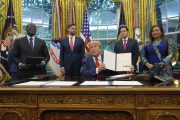
Freedom of Information Act requests have led to turning over e-mails that detail significant collusion between the Environmental Protection Agency and green activist groups over the climate agenda. The Energy and Environment Legal Institute (E&E Legal) released a report on Monday based on an analysis of dozens of e-mails received under FOIA requests, all of which point to a collusive relationship between senior activists and the EPA. The revelations are sure to raise questions on the legality of EPA rules.
The lengthy report details a variety of instances of lobbyists for special interest groups helping to push EPA regulations and decisions. It also notes that members of these groups virtually infiltrated the EPA and worked from within to circulate materials to colleagues and continue to advance the environmentalist agenda. Items on that agenda range from orchestrating public hearings to the targeting of individual power plants through new EPA standards.
The collection of e-mails outlines a close relationship between environmental groups and senior EPA officials, many of whom came from those environmental groups. One such relationship is that between Michael Goo, recently head of the EPA Office of Policy and a former Natural Resources Defense Council (NRDC) lobbyist, and John Coequyt, a top Sierra Club lobbyist. According to the e-mails, Coequyt supplied materials directly to individual activists within EPA, even helping EPA keep a score for “internal use” of coal plants to shut down. Coequyt saw to it that plans to build new coal plants ultimately did not come to fruition.
Coequyt wrote to Goo and another EPA staffer to pressure the EPA into adopting regulations so strict that coal plants that had already received construction permits could not be built. “Attached is a list of plants that the companies shelved because of uncertainty around GHG regulations. If a standard is set that these plants could meet, there is a not small chance that they [sic] company could decide to revive the proposal,” Coequyt wrote.
On many occasions, Coequyt met with Goo at the nearby Marriott Hotel, purposely avoiding EPA headquarters so that they did not have to detail their discussions in EPA’s visitor logs.
E-mails also reveal that EPA press staff worked directly with a Sierra Club lobbyist to write Senator Jeanne Shaheen’s (D-N.H.) statement on the climate agenda for an event in which the EPA, Sierra Club, and Senator Shaheen participated.
“It’s disturbing,” remarks Dr. David Schnare, a lawyer and scientist for the E&E Legal’s general counsel who served for decades as an EPA employee. “There needs to be a clear line between special interests and government. Current EPA officials are ignoring that line entirely.”
On a number of occasions, green lobbyists were provided an opportunity to submit comments ahead of members of the general public or other interested parties. EPA employees even went as far as submitting special interest group comments directly when those groups did not do so.
“The exclusion of voices from the process other than those already predisposed to agree with and promote EPA’s agenda, its leadership’s former compatriots in ‘green’ lobbying groups, is the precise and illegal opposite of good governmental practices,” said Craig Richardson, E&E legal’s executive director. “These people are not allowed to regulate this way.”
Examination of the e-mails shows just how deep the collusion ran, as EPA Administrator Lisa Jackson, a.k.a. “Richard Windsor,” used her private Verizon account to e-mail directly, off the record, green lobbyists such as Sierra Club’s Michael Brune.
E&E Legal’s report is not the first indication the public has had of the collusive relationship between green groups and the EPA.
Earlier this year, e-mails obtained under a Freedom of Information Act request revealed that the EPA had been plotting with environmental groups to kill the Keystone XL pipeline, which would run from Canada to Texas. The request was filed by the same Energy and Environmental Legal Institute under its former name, the American Tradition Institute.
For months, the EPA refused to process the requests, and an EPA FOIA specialist admitted that she and her colleague were instructed not to work on the requests.
Many of the collusive e-mails were between the EPA and the Sierra Club.
One communication revealed Lena Moffit of the Sierra Club writing to three senior policy staffers at the EPA, including Michael Goo, then the associate administrator for policy, on the subject of the Keystone XL pipeline.
An e-mail from Moffit to Alex Barron, EPA senior advisor in the Office of Policy, acknowledged a strategy session that took place the day before with agency officials: “Thanks so much for taking the time to meet with us on Keystone XL yesterday…. I know this is a tough issue but please do let me know if I can be helpful in any way — particularly in further identifying those opportunities for EPA to engage that don’t involve ‘throwing your body across the tracks,’ as Michael put it.”
Chris Horner of the Energy and Environment Legal Institute noted at the time that as a government agency, the EPA cannot overtly attempt to kill the pipeline, and therefore must reach out to environmental groups for ideas on how to do it.
The newly released report determines that despite assertions that the EPA is pursuing a “common-sense agenda,” the agency is working to advance an ideological agenda set forward by Obama that intends to “bankrupt” coal. The report reads, “Emails prove this agenda is assisted both in its big picture and in detail by pressure groups from which EPA obtained many senior staff.”
The findings also indicate that regardless of promises for transparency, the agenda is anything but transparent. “The public shift to more moderate positions was purely rhetorical, in response to political pressures,” the report reads. It continues,
The truth of how EPA operates also is starkly contrary to Mr. Obama’s promises of limiting the [power] of special interests, the revolving door, and transparency. Contrary to candidate Obama’s promise to run the “most transparent administration in history,” free of conflicts of interest, documents reveal that various environmentalist pressure groups with extreme agendas have unprecedented access to and influence upon their former colleagues and other ideological allies who are now EPA officials. EPA serves as an extension of these groups and neither EPA nor the groups recognize any distinction between them.
“This series of correspondence plainly indicates that you’ve got an agency that’s made up its mind — working with allies with whom it is ideologically and substantively aligned on this — trying to find ways to advance their argument without being too obvious about it,” Horner concludes.





